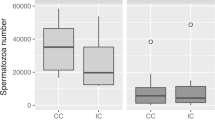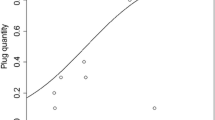Abstract
Males can change their copulatory or sperm transfer patterns in response to sperm competition risk. Schizocosa malitiosa performs long copulations, which include two consecutive patterns (Patterns 1 and 2). Virgin females are very sexually receptive, but mated females diminish their receptiveness. Female unreceptivity has been attributed to the action of receptivity-inhibiting substances, mainly transferred during Pattern 1. We tested: (1) if females who mated only with Pattern 1 were immediately unreceptive; (2) male and female behaviours when the copulating couple was exposed to another male. For (1), we interrupted mating when Pattern 1 finished and immediately exposed the female to a second male. For (2), we introduced a second male when the couple was starting (Ei) or finishing copulation (Li). Females were unreceptive immediately after finishing Pattern 1. Males from Ei and Li dismounted and approached the second males. Ei males diminished the frequencies of insertion after perceiving the presence of a second male and dismounted less frequently when copulating with heavy females. The study provides insights about the timing of sexual unreceptivity in S. malitiosa under possibilities of sperm competition, discussing male adjustment of copulatory behaviour in the presence of rival males.

Similar content being viewed by others
References
Aisenberg A, Costa FG (2005) Females mated without sperm transfer maintain high sexual receptivity level in the wolf spider Schizocosa malitiosa. Ethology 111(6):545–558
Andrade MCB (1996) Sexual selection for male sacrifice in the Australian redback spider. Science 271:70–72
Arnqvist G, Andrés JA (2006) The effects of experimentally induced polyandry on female reproduction in a monandrous mating system. Ethology 112:748–756
Arnqvist G, Nilsson T (2000) The evolution of polyandry: multiple mating and female fitness in insects. Anim Behav 60:145–164
Arnqvist G, Rowe L (2005) Sexual conflict. Princeton University Press, Princeton
Austad SN (1984) Evolution of sperm priority patterns in spiders. In: Smith RL (ed) Sperm competition and the evolution of animal mating systems. Academic Press, New York, pp 223–249
Bergström J, Wiklund C, Kaitala A (2002) Natural variation in female mating frequency in a polyandrous butterfly: effects of size and age. Anim Behav 64:49–54
Birkhead TR, Møller AP (1998) Sperm competition and sexual selection. Academic Press, London
Byrne PG, Rice WR (2006) Evidence for adaptive male mate choice in the fruit fly Drosophila melanogaster. Proc R Soc B 273:917–922
Chapman T (2006) Evolutionary conflicts of interest between males and females. Curr Biol 16:744–754
Chen PS (1984) The functional morphology and biochemistry of insect male accessory glands and their secretions. Ann Rev Entomol 29:233–255
Costa FG (1975) El comportamiento precopulatorio de Lycosa malitiosa Tullgren (Araneae, Lycosidae). Rev Brasil Biol 35:359–368
Costa FG (1979) Análisis de la cópula y de la actividad postcopulatoria de Lycosa malitiosa Tullgren (Araneae, Lycosidae). Rev Brasil Biol 39:361–376
Costa FG (1991) Fenología de Lycosa malitiosa Tullgren (Araneae, Lycosidae) como componente del criptozoos en Marindia, localidad costera del sur de Uruguay. Bol Soc Zool Uruguay 2ªépoca 6:8–21
Costa FG, Toscano-Gadea CA (2003) Experimental interruption and re-initiation of mating in a wolf spider: an analysis of behavioural patterns and resultant progeny. Ethol Ecol Evol 15:173–181
Costa FG, Simó M, Aisenberg A (2006) Faunística y ecología de la fauna costera de Marindia (Canelones, Uruguay) con especial énfasis en las arañas: un estudio de dos años con trampas de intercepción. In: Menafra R, Rodríguez-Gallego L, Scarabino F, Conde D (eds) Bases para la conservación y el manejo de la costa uruguaya. Vida Silvestre, Montevideo, pp 427–436
Eberhard WG (1996) Female control: sexual selection by cryptic female choice. Princeton University Press, Princeton
Eberhard WG (2004) Why study spider sex: special traits of spiders facilitate studies of sperm competition and cryptic female choice. J Arachnol 32:545–556
Eberhard WG, Cordero C (2003) Sexual conflict and female choice. Trends Ecol Evol 18:438–439
Eberhard WG, Guzmán-Gómez S, Catley KM (1993) Correlation between spermathecal morphology and mating systems in spiders. Biol J Linn Soc 50:197–209
Eberhard WG, Huber BA, Rodríguez-Sevilla RL, Briceño RD, Salas I, Rodríguez V (1998) One size fits all? Relationships between the size and degree of variation in genitalia and other body parts in twenty species of insects and spiders. Evolution 52(2):415–431
Elgar MA (1992) Sexual cannibalism in spiders and other invertebrates. In: Elgar MA, Crespi BJ (eds) Cannibalism: ecology and evolution among diverse taxa. Oxford University Press, Oxford, pp 128–155
Elgar MA (1998) Sperm competition and sexual selection in spiders and other arachnids. In: Birkhead TR, Møller AP (eds) Sperm competition and sexual selection. Academic Press, London, pp 307–339
Elgar MA, Bathgate R (1996) Female receptivity and male mate-guarding in the jewel spider Gasteracantha minax thorell (Araneidae). J Insect Behav 9:729–738
Elgar MA, Champion de Crespigny FE, Ramamurthy S (2003) Male copulation behaviour and the risk of sperm competition. Anim Behav 66:211–216
Estramil N, Costa FG (2007) Female sexual receptivity after partial copulations in the wolf spider (Schizocosa malitiosa). J Zool 271:148–153
Foelix RF (1996) Biology of spiders, 2nd edn. Oxford University Press, New York
Gage MJG (1998) Influences of sex, size, and symmetry on ejaculate expenditure in a moth. Behav Ecol 9:592–597
García-González F, Gomendio M (2004) Adjustment of copula duration and ejaculate size according to the risk of sperm competition in the golden egg bug (Phyllomorpha laciniata). Behav Ecol 15:23–30
Gillott C (1988) Arthropoda—insecta. In: Adiyodi KG, Adiyodi RG (eds) Reproductive biology of invertebrates. Wiley, New York, pp 317–471
Gillott C (2003) Male accessory gland secretions: modulators of female reproductive physiology and behavior. Annu Rev Entomol 48:163–184
Hammer O, Harper DAT, Ryan PD (2003) PAST: PAlaeontological STatistics, version 1.18. Home page at http://folk.uio.no/ohammer/past
Huber BA (2005) Sexual selection research on spiders: progress and biases. Biol Rev 80:363–385
Michalik P, Uhl G (2005) The male genital system of the cellar spider Pholcus phalangioides (Fuesslin, 1775) (Pholcidae, Araneae): development of spermatozoa and seminal secretion. Front Zool 2:12
Moya-Laraño J, Cabeza M (2003) Bimodality in the body size distribution of Mediterranean tarantula juveniles: Humphreys’ Russian roulette revisited. Rev Ibérica de Aracnol 7:211–219
Norton S, Uetz GW (2005) Mating frequency in Schizocosa ocreata (Hentz) wolf spiders: evidence for a mating system with female monandry and male polygyny. J Aracnhol 33:16–24
Parker GA (1970) Sperm competition and its evolutionary consequences in the insects. Biol Rev 45:525–567
Parker GA (1979) Sexual selection and sexual conflict. In: Blum MS, Blum NA (eds) Sexual selection and reproductive competition in insects. Academic Press, London, pp 123–166
Parker GA (1984) Sperm competition and the evolution of animal mating strategies. In: Smith RL (ed) Sperm competition and the evolution of animal mating systems. Academic Press, New York, pp 2–60
Parker GA (1998) Sperm competition and the evolution of ejaculates: towards a theory base. In: Birkhead TR, Møller AP (eds) Sperm competition and sexual selection. Academic Press, London, pp 3–54
Parker GA, Ball MA, Stockley E, Gage MJG (1997) Sperm competition games: a prospective analysis of risk assessment. Proc R Soc Lond B 246:107–115
Poiani A (2006) Complexity of seminal fluid: a review. Behav Ecol Sociobiol 60:289–310
Rowe L, Arnqvist G (1996) Analysis of the causal components of assortative mating in water striders. Behav Ecol Sociobiol 38:279–286
Schäfer MA, Uhl G (2002) Determinants of paternity success in the spider Pholcus phalangioides (Pholcidae: Araneae): the role of male and female mating behaviour. Behav Ecol Sociobiol 51:368–377
Schäfer MA, Uhl G (2004) Sequential mate encounters: female but not male body size influences female remating behavior. Behav Ecol 16:461–466
Simmons LW (2001) Sperm competition and its evolutionary consequences in the insects. Princeton University Press, Princeton
Simmons LW (2005) The evolution of polyandry: sperm competition, sperm selection, and offspring viability. Annu Rev Ecol Evol Syst 36:125–146
Siva-Jothy MT (2000) The young sperm gambit. Ecol Lett 3:172–174
Thornhill R, Alcock J (1983) The evolution of insect mating systems. Harvard University Press, Cambridge
Uhl G (1998) Mating behaviour in the cellar spider, Pholcus phalangioides, indicates sperm mixing. Anim Behav 56:1155–1159
Useta G, Huber BA, Costa FG (2007) Spermathecal morphology and sperm dynamics in the female Schizocosa malitiosa (Tullgren 1905) (Araneae: Lycosidae). Eur J Entomol 104:777–785
Vahed K (1998) The function of nuptial feeding in insects: a review of empirical studies. Biol Rev 73:43–78
Vahed K (2007) All that glisters is not gold: sensory bias, sexual conflict and nuptial feeding in insects and spiders. Ethology 113:105–127
Wedell N, Gage MJG, Parker GA (2002) Sperm competition, male prudence and sperm-limited females. Trends Ecol Evol 17:313–320
Wiklund C, Karlsson B, Leimar O (2001) Sexual conflict and cooperation in butterfly reproduction: a comparative study of polyandry and female fitness. Proc R Soc Lond 268:1661–1667
Acknowledgments
We are very grateful to Fernando G. Costa for his helpful comments on the experimental design and suggestions for the manuscript. We thank Mark A. Elgar, an anonymous reviewer, the Associate Editor and Editor Yoshitaka Tsubaki for their comments and suggestions that substantially improved the manuscript. We also thank Luciana Baruffaldi for helping with the capture and breeding of the spiders. The experiments comply with the current Uruguayan and institutional laws.
Author information
Authors and Affiliations
Corresponding author
Electronic supplementary material
Below is the link to the electronic supplementary material.
10164_2007_81_MOESM1_ESM.rtf
Table S1. Cephalothorax length (cl), cephalothorax width (cw) and weight of individuals used in each experimental group. Data presented as Mean ± SD, with the corresponding range between brackets (RTF 34.8 kb)
About this article
Cite this article
Aisenberg, A., Estramil, N., Toscano-Gadea, C. et al. Timing of female sexual unreceptivity and male adjustment of copulatory behaviour under competition risk in the wolf spider Schizocosa malitiosa . J Ethol 27, 43–50 (2009). https://doi.org/10.1007/s10164-007-0081-9
Received:
Accepted:
Published:
Issue Date:
DOI: https://doi.org/10.1007/s10164-007-0081-9




